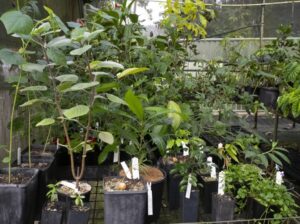
Unique local plants at Cairns Botanic Gardens
By Cadel Boyce
The role of botanic gardens in recent years has changed from a focus on displaying the breadth of the world’s flora to facilitating a living collection of both exotic and local native plants of importance. Australia has a unique floral biodiversity due to its long geological period of isolation. Unfortunately, the increase in human development and introduced diseases have driven many of these plants to be listed as threatened. Botanic gardens across the country are implementing new and interesting projects focusing on what they can do for the threatened flora in their local regions. Cairns Botanic Gardens has embraced this way of thinking by focusing on threatened and unique plant species from the Wet Tropics to build a new collection of Australian natives. This will add much-needed conservation and research value to our existing living collection.
Since my appointment as the Interpretive officer at the Cairns Botanic Gardens, a key focus of these gardens has been to improve the living collection of native and unique species from Australia and New Guinea. In the past, our garden has been a focus of exotic plants from around the tropics including Southeast Asia, South America and Africa. This is most prominent in the Flecker Garden, a heritage listed, exotic tropical garden. This listing limits the ability to change the presentation of the Flecker Garden collection, but this does not mean that local threatened natives do not have a place in Flecker Garden, or other gardens within the precinct.
Within Flecker Garden, rare understorey rainforest shrubs and unique shrubs and herbs of the Atherton Tablelands can fit easily amongst the showy exotics that give the garden its unique aesthetic. In other parts of the Gardens such as the Gondwanan Evolution Garden where the canopy has already been established, more native understorey shrubs and ground cover can be displayed to compliment the collection of rare and unique trees of the Australian Wet Tropics.
Another area of improvement that is being focused on is the lack of plants with known provenance data within the living collection. As a small regional botanic garden, our ability to conduct our own botanical research is limited. However, by collaborating with James Cook University (JCU) and the Australian Tropical Herbarium (ATH), we can participate in research expeditions to bring these unique and rare species into the gardens in a meaningful way. Thereby, we can complement larger living collections of native species, such as the collection at the JCU Townsville Campus.
Driving this focus on local native plants to boost conservation value within the living collection is both the need to enhance public education around these unique species and the difficulty in acquiring exotic plants with sufficient provenance data that could be used in research. Australia has some of the strictest biosecurity laws in the world. These sometimes act as a double-edged sword. On the one hand, these laws protect our unique native flora from exotic diseases being readily brought into the country. On the other hand, they limit how botanical gardens can acquire plants, particularly exotic tropical species that often come from less ‘biosecure’ countries. As a result, this has led to Cairns Botanic Gardens putting most of our effort into the much more cost-effective collection of native species through the ongoing collaboration with JCU.
All this work aims to use the existing collection at Cairns Botanic Gardens as a foundation for adding greater conservation and research value by introducing threatened and unique native species that complement major collections held elsewhere in Australia. As the gardens in Cairns are currently the only botanic garden operating in the Wet Tropics region, the focus moving forward will be on unique species from this area as well as from the rainforests of New Guinea. There is our hope that in the future, specimens housed in the Cairns Botanic Gardens can be used in research into Australia’s tropical flora, complementing the work done by larger botanical gardens such as the Royal Botanic Gardens in Sydney and Melbourne.
Cadel Boyce
Interpretative Officer Botanic Gardens
Cairns Botanic Gardens
E: Cadel.Boyce@cairns.qld.gov.au
